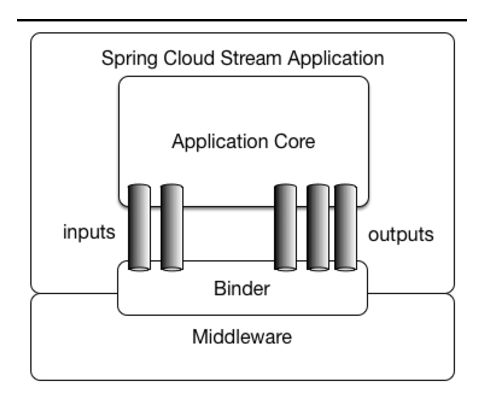srping cloud stream rocketmq
项目地址
rockermq样例地址
spring cloud stream解决的痛点是什么
屏蔽了各种MQ的差异,统一了编程模型(可以类比成基于MQ通信圈的”Spring Data”)
前提rocketmq已启动
第一步
导入spring cloud的依赖 决定使用哪个版本
org.springframework.cloud
spring-cloud-dependencies
Finchley.SR2
pom
第二步
引入 spring cloud stream的依赖
org.springframework.cloud
spring-cloud-stream
2.1.0.RELEASE
第三步
加入 spring cloud rocketmq 的依赖
org.springframework.cloud
spring-cloud-stream-binder-rocketmq
0.2.1.RELEASE
至此 基础操作就完成了
然后修改application为yml 开始编写测试用例
rocketmq对spring cloud stream 实现的步骤

使用spring cloud stream 主要是使用binder跟binding

看图可知 ,通过binder绑定消息中间件, 通过input跟output两个通道进行消息的接收跟发送
binder表示绑定具体哪一个消息中间件
Binding: 包括 Input Binding 和 Output Binding。 Binding 在消息中间件与应用程序提供的
Provider 和 Consumer 之间提供了一个桥梁,实现了开发者只需使用应用程序的 Provider 或 Consumer
生产或消费数据即可,屏蔽了开发者与底层消息中间件的接触。
我们会用到@input 跟@output两个注解
@input表示消费者通道(订阅)
@output是生产者通道(生产消息)
注解配置rocketmq的地址
因为 stream可以接入多个消息中间件 可以设置默认 中间件
yml配置
设置input output 这里的名字可以自己定义 需要跟注解定义的对应起来
spring:
cloud:
stream:
rocketmq:
binder:
namesrv-addr: 127.0.0.1:9876
# 定义name为output的binding
bindings:
output1:
destination: test-topic
content-type: application/json
# 定义name为input的binding
input1:
destination: test-topic
content-type: application/json
group: test-group
server:
port: 1000
binding跟rocketmq同级
自定义output input 原本又source.class跟sink.class定义了 这里我们自定义尝试下
public interface StreamClient {
@Input("input1")
SubscribableChannel input1();
@Output("output1")
MessageChannel output1();
}
这里假使你@input 注解跟@output注解 引号内字符串一致,就会报无效的错误
编写接收者
@Component
@EnableBinding(StreamClient.class)
@Slf4j
public class MQReciver {
@StreamListener("input1")
public void test(String message){
log.info(message);
}
}
编写消息发送者 这列我们通过controller 调用
@RestController
@RequestMapping("test")
public class MQRest {
@Autowired
StreamClient streamClient;
@GetMapping("mq")
public void test(){
String now = "now" + new Date();
streamClient.output1().send(MessageBuilder.withPayload(now).build());
}
}
到此 你启动 应用后 调用接口 就会 收到发送的消息了